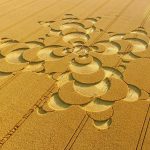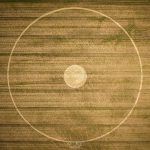Crop circles have intrigued and puzzled observers for decades. These formations often display an extraordinary degree of mathematical and geometric sophistication that goes beyond simple human artistry. This article explores the mathematical and geometric intricacies of crop circles, highlighting their implications and the mysteries they present.
The Notched Spiral Numeracy Concept
A notable feature of crop circles is the notched spiral numeracy concept, which involves spirals with evenly spaced notches aligned with mathematical constants and sequences.
- Barbury Castle Trinary Formation (1991): This early crop circle displayed a trinary code system, indicating an advanced understanding of binary and trinary mathematics. The notched spiral within this formation was an early sign of the complex patterns that would follow.
- Geometric Pi Representation (2005): A crop circle near Milk Hill depicted the first ten digits of pi (π) encoded within a notched spiral. This formation demonstrated an impressive grasp of mathematical representation and precision.
- Kozvarce Sacred Geometry (2012): In Slovakia, the Kozvarce formation used notched spirals to illustrate complex sacred geometry concepts, blending mathematical accuracy with ancient symbolic meaning.
Fractals and Recursive Patterns
Fractals, recursive geometric patterns that repeat at every scale, are a hallmark of many crop circles, reflecting natural mathematical principles.
- Mandelbrot Set (1992): Near Alton Barnes, a crop circle depicted the Mandelbrot set, a renowned fractal pattern. The complexity and accuracy of this design suggested a deeper understanding of fractal geometry.
- Julia Set (1996): Found near Stonehenge, this pattern featured a Julia set fractal, further demonstrating advanced mathematical knowledge.
- Trinary Julia Set (2009): An extension of the 1996 Julia set formation, this crop circle integrated trinary concepts with fractals, showcasing an evolved understanding of these geometric principles.
- Milk Hill Galaxy Spiral (2005): This formation featured a galaxy spiral pattern using circles, echoing fractal geometry and reflecting natural spiral structures.
Novel Mathematical Geometry Concepts
Crop circles often introduce novel mathematical geometry concepts, pushing the boundaries of our understanding.
- Geometric Pi Representation with Notched Spiral (2008): Near Barbury Castle, this crop circle expanded on earlier pi representations by incorporating a notched spiral, highlighting an intricate understanding of pi’s mathematical significance.
- Euler’s Identity Binary Disc (2010): Near Wilton Windmill, a crop circle featured Euler’s identity (e^(iπ) + 1 = 0) encoded within a binary disc, demonstrating a profound grasp of one of mathematics’ most elegant equations.
Cymatic Patterns and Objective Patterns in Nature
Cymatics, the study of visible sound and vibration, often influences crop circle designs, reflecting natural geometries produced by sound frequencies.
- Cymatic Pattern Series (2001): Beginning in 2001, a series of crop circles depicted cymatic patterns resembling those from vibrating plates or membranes, mirroring natural geometric patterns seen in biological and physical processes.
- Objective Patterns in Nature: Crop circles frequently replicate objective patterns from nature, such as the Fibonacci sequence and the Golden Ratio, suggesting a connection between the creators of these formations and fundamental natural principles.
DNA Representations
Crop circles have occasionally featured formations that appear to reference DNA and genetic codes.
- DNA Disc (2002): This formation depicted a pattern resembling a DNA double helix, suggesting an advanced understanding of biological concepts.
- South Korea DNA Formation (2008): A crop circle in South Korea also appeared to represent DNA, reinforcing the notion that these formations might convey messages related to genetics and life itself.
Star Maps and Extraterrestrial Geometry
Some crop circles appear to represent star maps and extraterrestrial geometries, hinting at potential connections to space and otherworldly civilizations.
- Star Map Formation (2014): A crop circle in England seemed to represent a star map, aligning with known constellations and celestial bodies, fueling speculation about extraterrestrial involvement.
- Arecibo Signal Response (2001): A famous crop circle in Chilbolton, England, appeared to be a response to the Arecibo message sent into space in 1974. This formation depicted a similar message with significant alterations, suggesting an advanced intelligence capable of understanding and responding to human communication.
Conclusion
The mathematical and geometric sophistication of crop circles challenges conventional explanations and points to a deeper intelligence behind their creation. From notched spirals and fractals to cymatic patterns and DNA representations, these formations embody complex principles that align with advanced scientific and mathematical concepts. Whether created by human hands or something more enigmatic, crop circles continue to captivate and inspire, hinting at profound connections between art, mathematics, and the natural world.
As we delve deeper into these enigmatic designs, we may uncover even more about their origins and meanings. The study of crop circles offers a fascinating glimpse into the intersection of art, science, and the mysteries that surround us.










